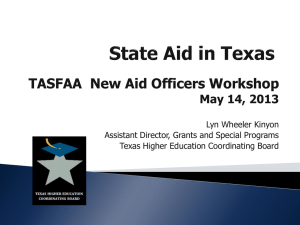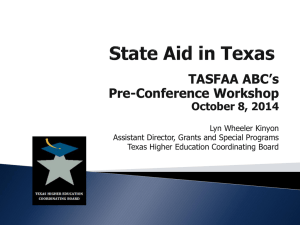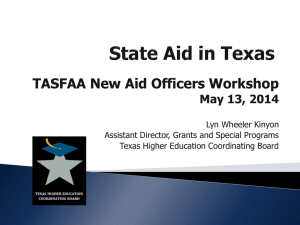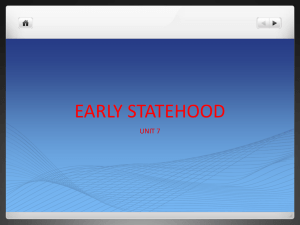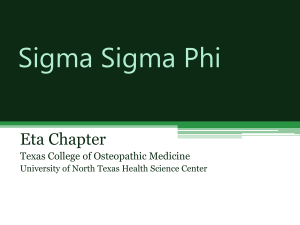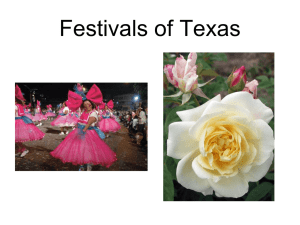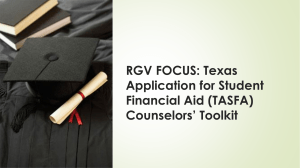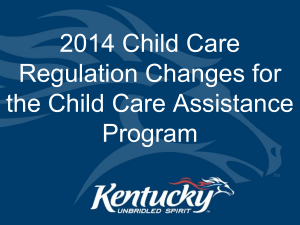Financial Aid for Texas Students
advertisement
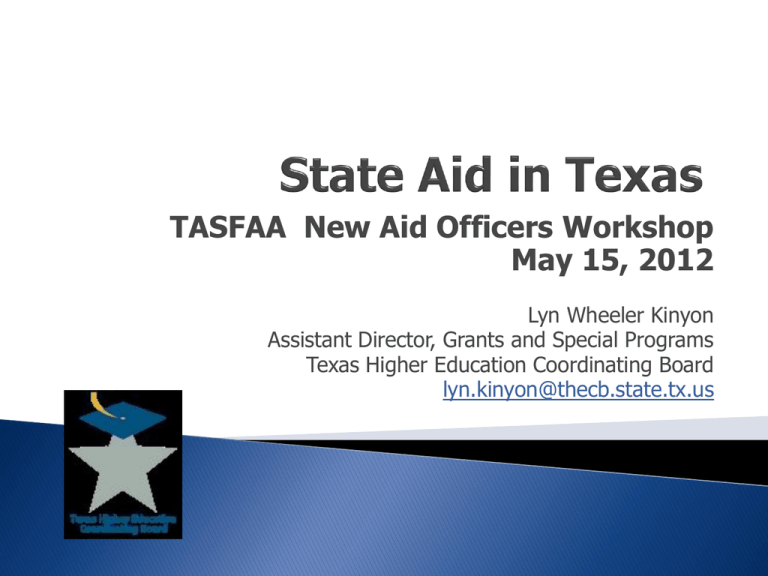
TASFAA New Aid Officers Workshop May 15, 2012 Lyn Wheeler Kinyon Assistant Director, Grants and Special Programs Texas Higher Education Coordinating Board lyn.kinyon@thecb.state.tx.us • Purpose Created by the Texas Legislature in 1965 to provide leadership and coordination for the Texas higher education system to achieve excellence for the college education of Texas students. • Responsibilities • Assess the state of higher education in Texas; • Develop recommendations to the Legislature, Governor, and institutions for its enhancement; and • Establish policies for the efficient and effective use of the state’s higher education resources. 2 Workforce, Academic Affairs and Research • Academic Affairs and Research • Planning and Accountability • P-16 Initiatives Finance and Administration Business and Support Services • • Business Office • Grants and Special Programs (G&SP) * • Loan Programs Operations (LPO) * • Information Technology • Human Resources * Main areas that work closely with colleagues in the financial aid community. 3 • Provide service to students, families, and institutions. • Interpret legislation and develop rules. • Allocate available funding and process funding requests. • Process applications. • Collect student loan payments and process benefits. • Provide training. • Perform program reviews and audits. • Collect and provide information requested by the Legislature. 4 1. 2. 3. 4. Legislature passes a statute authorizing a program. Legislature appropriates funds – or not. THECB writes & adopts rules – if applicable. Programs are administered as: • Decentralized (Campus-Based) • CB allocates funding to the institution, applications submitted through the institution, the institution selects recipients, CB supplies funding to the institution, and the institution submits reports to the CB. • Solely at the institutional level • students apply through the institution, the institution determines eligibility, and the CB supplies no funding to the institution. • Centralized (CB-Based) • applications submitted to the CB, the CB selects and announces award recipients, and the CB supplies funding to the institution. 5 Grants, Scholarships, Loans, and Work. Exemptions – allow lower tuition/fees for certain groups. Waivers – allow non-resident students lower tuition rates. Trends: • Encourage efficiency through: • required enrollment. • performance. • completion. • Penalize inefficiency through: • time limitations. • drop limitations. • added costs for exceeding limitations. 6 Institutional 14% Federal $6,646,564,409 State $623,420,767 Institutional $1,328,685,982 Other $902,051,710 Total $9,500,722,868 Other 9.5% State 6.5% Federal 70% 7 Participation: ◦ ◦ ◦ ◦ ◦ ◦ Eligible institutions – defined in statute Signed agreements/MOU’s with the CB Statutes and rules Program guidelines and allocations Funding requests and required reports Audits and program reviews Shadowing Federal Processes: ◦ Federal Methodology (FM) FAFSA or TASFA (residents unable to complete FAFSA process) ◦ Verification ◦ SAP 8 Provide grants to needy students at public institutions. Funded through statutory tuition set-asides. Eligibility requirements: • enroll at a public institution • financial need • register with Selective Service or be exempt (not required of community colleges) Awarded based on institution’s policies and procedures. Eligibility continuation: • not an entitlement – renewal awards occur at the institution’s discretion • no statutory end to student eligibility 9 Provide grants to academically-prepared needy students at public institutions – funded through appropriations. Initial eligibility requirements: • entering undergraduate with the recommended high school curriculum (or higher) or an associate’s degree. • Texas resident with need, an EFC < 4,000, and enrolled at least ¾ time. • registered with Selective Service (or exempt) and no drug conviction. Renewal eligibility requirements: • calculated need • end of 1st year – institution’s SAP policy; end of 2nd year and thereafter – overall GPA of 2.5, 75% annual completion rate, and 24 SCH’s completed annually. • eligibility ends with bachelors, 150 SCH’s, or 5 yrs for 4-yr plan/6 yrs for 5-yr plan. 10 Stronger emphasis on need to improve student outcomes and increase student success by giving priority to financially needy students who achieved certain standards/proven success benchmarks. Priority will be given to students who meet the new priority deadline and have any two of the following : Advanced Academic Programs (12 SCH, DAP, or IB) Class Standing (top 3rd of class or B average) TSI Readiness (meet TSI thresholds or be exempt) Advanced Math (math class beyond Algebra II) If funds remain after priority students have been awarded, the balance of allocated funds can go to those who meet the basic requirements. Does not apply to community colleges or Lamar Institute of Technology 11 Provide grants to needy students at public 2-yr institutions. Funded through appropriations Initial eligibility requirements: • entering undergraduate not receiving a TEXAS Grant. • Texas resident with need, an EFC < 2,000, and enrolled at least ½ time. • registered with Selective Service (or exempt) and no drug conviction. Renewal eligibility requirements: • calculated need. • end of 1st year – institution’s SAP policy; end of 2nd year and thereafter – overall GPA of 2.5 and 75% annual completion rate. • ends with associate’s degree, 75 SCH’s, or 4 yrs. 12 Provide grants to needy students at private/non-profit institutions. Funded through appropriations. Eligibility requirements: • Texas resident or National Merit Finalist with need and enrolled at least ¾-time. • undergraduate or graduate. • registered with Selective Service (or exempt). • not receiving an athletic scholarship. • required to pay more tuition than is required at a comparable public institution. Eligibility continuation: • GPA of 2.5 and annual completion rate of 24 hrs per yr UG and 18 hrs per yr GR. • UG – 5 yr max for 4 yr degree, or 6 yr max for 5 yr degree. 13 Purpose is to encourage outstanding high school graduates in the top 10 percent of their class to attend a public institution in Texas. Funded through appropriations. Initial eligibility requirements: • Texas resident. • complete Recommended or higher curriculum and graduate from a public or private accredited high school in Texas. • rank in the top 10 percent of the HS graduating class. • submit the FAFSA in time to generate the CPS results in a non-rejected status, or submit the TASFA to the institution, by the established deadline . • meet need requirement (COA – EFC – PELL >=$1). • register with Selective Service or be exempt. • enroll full-time in the fall semester and maintain full-time enrollment through the census date of the semester. 14 Renewal eligibility requirements: • submit the FAFSA in time to generate the CPS results in a non-rejected status, or submit the TASFA to the institution, by the established deadline . • meet need requirement (COA – EFC – PELL >=$1). • enroll full-time in the fall semester and maintain full-time enrollment through the census date of the semester. • maintain a cumulative 3.25 GPA, complete at least 30 SCH in the previous year, and complete at least 75% of the hours attempted in the previous year. • Bachelor’s degree or 4 years – whichever comes first. Workforce bonus eligibility requirements: • major in critical workforce shortage area and enroll as a junior or senior. • have overall GPA of 3.0 at the beginning of the relevant junior or senior year. 15 Purpose is to provide eligible Texas students no-interest loans and loan forgiveness upon graduation for meeting specific goals. Funded through appropriations and tuition set-asides from 4-year public universities. Eligibility requirements: • Texas resident enrolled full-time and eligible for federal aid. Eligibility continuation: • end of 1st year – institution’s SAP policy. • thereafter, overall GPA of 2.5; 75% completion in the most recent year. • ends with completion of a Bachelor’s degree or 150 hours of BOT. Repayment benefits: • loan forgiveness if graduation within a certain time frame, number of hours, and GPA. • 0% interest loan if not eligible for forgiveness. 16 • Purpose is to provide alternative loans to Texas students who are unable to meet the cost of attendance. • Available at public and private/non-profit institutions. • Funded through the sale of state bonds. • Eligibility requirements: • Texas resident enrolled at least ½ time. • receive a favorable credit evaluation or provide an eligible cosigner who has good credit standing. • meet the institution’s SAP policy. 17 Purpose is to provide eligible Texas students employment as a means to fund their education. Available at public and private institutions and funded through appropriations. Matching funds required unless proof is provided that matching is waived for FCWS. Eligibility requirements: • • • • Texas resident with financial need and enrolled at least ½-time. Registered with Selective Service (or exempt). Not receiving an athletic scholarship. Not enrolled in a seminary or other religious program. 18 Exemptions/Waivers: • Hazlewood, Peace Officers, Fire Fighters, Blind/Deaf, Valedictorian, Competitive Scholarship Waiver, etc. Scholarships: • Kenneth Ashworth Scholarship, Good Neighbor Scholarship, etc. State/Federal Programs not funded or discontinued: • Educational Aide Exemption * • Early High School Graduation Scholarship • Combat Exemption * • Professional and Vocational Nursing Scholarships • TANF Exemption * • Byrd Scholarship • LEAP/SLEAP Grants * Exemption may be honored without funding. 19 1-800-242-3062 or 512-427-6340 grantinfo@thecb.state.tx.us Contact sheet G&SP Distribution List: • Official communications • program guidelines, allocations, Q&A’s, etc. • Subscribe or unsubscribe: • http://lists.state.tx.us/mailman/listinfo/txgnsp-l http://collegeforalltexans.com/ https://www1.thecb.state.tx.us/apps/SpecialPrograms/ 20

